How Ships Are Born
 Last time I talked about the distance you can see a big ship on the horizon and how their height meant that you would be able to see the bridge of a ship but not the waterline as it was below the horizon. Currently the biggest ships in service are two ultra large crude carriers (ULCC) called ‘Africa’ and ‘Asia’ which are just over a quarter of a mile long! Their draught, loaded, is over 80 feet and they have speed of 16.5 knots which is about 19mph.
Last time I talked about the distance you can see a big ship on the horizon and how their height meant that you would be able to see the bridge of a ship but not the waterline as it was below the horizon. Currently the biggest ships in service are two ultra large crude carriers (ULCC) called ‘Africa’ and ‘Asia’ which are just over a quarter of a mile long! Their draught, loaded, is over 80 feet and they have speed of 16.5 knots which is about 19mph.
Imagine trying to stop that lot when it has worked up full speed. Just in passing what is meant by a crude carrier? It’s crude oil, virtually straight out of the ground, which is the raw material for an oil refinery. What comes out of the refinery is light oil, almost anything which is ready for use – petrol, diesel, car oil etc. Crude oil is very nearly solid when removed from ground pressure and crude oil tankers have to be equipped with heating coils in their tanks so that they can warm it up when they want to discharge. Light oils are liquid and can be pumped normally.
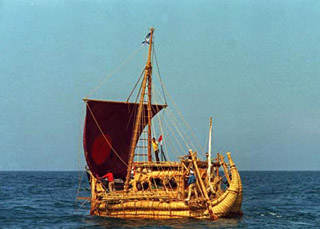 When I first started work after leaving school I worked as a clerk for the British Tanker Company at Finsbury Square in London. It was there I learnt a bit about shipbuilding and tankers in particular. As one of the office juniors there was a little perk we used to get occasionally. When a ship is built it is ordered by the shipping company from the builders.
When I first started work after leaving school I worked as a clerk for the British Tanker Company at Finsbury Square in London. It was there I learnt a bit about shipbuilding and tankers in particular. As one of the office juniors there was a little perk we used to get occasionally. When a ship is built it is ordered by the shipping company from the builders.
Construction begins and eventually the vessel is launched. Up to that point the ship is owned by the builder. When all is ready they take the ship to sea for trials and on board will also be the representative of the shipping company. They put the ship through its paces and, if all is good, the shipping company’s representative will sign for the ship and it is theirs. They can’t, however, take it to sea. Just like your car it has to be registered and it cannot be used until the registration document is prepared.
The Registrar of British Ships used to live at St Mary Axe in London, though it has now been taken over by the Maritime and Coastguard Agency (they get everywhere!). Once the ship had been signed for the Registrar was told, presumably by telephone in those days, and he would complete the Registration Book. Our job was to stay behind after work, go round to the Registrar, collect the book and take it to a main London railway station.
There we handed the book over to the Guard against signature and, presumably, when the train got to Newcastle or Glasgow, someone would meet the train and take the book to the ship. Our perk was that we got an allowance to buy our tea at the Aerated Bread Company opposite our office and were given a taxi fare for the station! How times have changed – and probably far less fun.
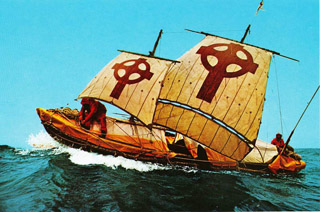 Anything that floats can be made in to a boat. For my purposes now I am excluding rafts and canoes and concentrating on sea going craft large enough to carry several men or cargo. One of the great authorities on ancient craft was Thor Heyerdahl, a Norwegian, who was prepared to put his money where his mouth was and built and actually sailed ancient craft.
Anything that floats can be made in to a boat. For my purposes now I am excluding rafts and canoes and concentrating on sea going craft large enough to carry several men or cargo. One of the great authorities on ancient craft was Thor Heyerdahl, a Norwegian, who was prepared to put his money where his mouth was and built and actually sailed ancient craft.
Kon-Tiki was built of balsa wood logs and, in 1947, he sailed it across the Pacific for 4300 miles! In 1969 he built an Egyptian reed boat, ‘Ra’, and sailed that from Morocco to towards the West Indies but she broke up on the way. Undeterred he built another the following year and succeeded in getting to Barbados. However the fate of the first ‘Ra’ probably underlined the fact that reed boats at sea were not a good idea – wave action tended to break them up.
Along came Tim Severin with ‘Brendan’, a leather boat – or at least tanned ox hides stitched together with leather thongs. He chose a much more testing voyage and went north from Ireland to Iceland, then Greenland and Labrador, a north Atlantic crossing which proved that, without doubt, a traditional Irish curragh, 36ft long, could be sailed in extreme conditions. Severin is an explorer who has made a life looking at the legends of time and saying, “Could it be done – was it possible?”. A well worthwhile read if you come across his books, for example “The Brendan Voyage”.
For centuries in this country wood was the ship building material and our forests have been denuded as a result. Most of southern England, Cornwall included, was covered in forest, particularly oak, that provided the ‘wooden walls’ of the Royal Navy. Shipwrights were skilled in the qualities of different woods for particular tasks. Larch could be steamed and bent, ash gave long straight spars, greenheart was practically rot proof and oaks could be persuaded to grow branches in various angles which, when cut, could provide corner sections which required no bending and so were stronger.
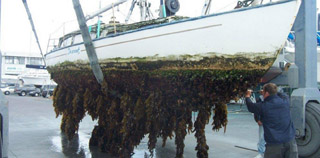 The 1830’s saw the first metal ships made of iron and the first proper warship built solely of iron was HMS Warrior, launched in 1860, though the French cheated in 1859 building a wooden warship, the ‘Gloire’, which they sheathed in iron plates. The Warrior is still in existence after a long career from warship to store ship. A major restoration begun in 1979 which now sees her as a museum in Portsmouth owned by the Maritime Trust.
The 1830’s saw the first metal ships made of iron and the first proper warship built solely of iron was HMS Warrior, launched in 1860, though the French cheated in 1859 building a wooden warship, the ‘Gloire’, which they sheathed in iron plates. The Warrior is still in existence after a long career from warship to store ship. A major restoration begun in 1979 which now sees her as a museum in Portsmouth owned by the Maritime Trust.
Then they hit another problem. Wooden ships were usually sheathed in copper and this kept the various worms and marine encrustations away. You could not sheath an iron ship because the metals fought one another when you added salt water so early iron ships quickly grew a stern to bow beard which slowed them down to the point where they became uneconomical to run. To get round that they either made an iron framework to which they fastened a wood casing or, in the case of the ‘Great Britain’’, now in Bristol, they built an iron hull and sheathed it in wood. Nothing in life is simple!
The 1880’s saw a move away from iron to steel. It is easier to bend, it is harder and lighter, and by the turn of the century it was the sole material in use for ships’ hulls. In this country the north of England and south of Scotland was shipbuilding heartland, lifeblood of the big coastal towns. Everything from trawlers to big ocean liners rolled off the slipways and we were the shipbuilding hub of the world.
It was a highly skilled trade from design to construction, right down to those who simply put the ship together. A steel framework was built to exact specification then the side plates were cut to make the hull. These huge sheets of steel had to be exact else they would not fit. Holes were drilled at the edges, everyone to match up with its partner plate and the rib framework. If the holes did not line up exactly you could not rivet them.
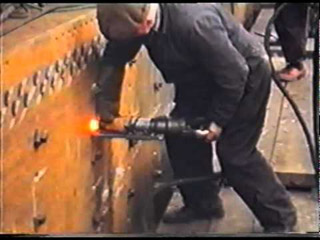 The riveter and his mates were a team, one inside and two outside the hull. The rivets, like solid steel bolts, were heated white hot on a furnace outside the hull, picked up with heavy pincers and slid into the hole. On the inside of the hull the riveter then hammered the red hot metal flat while his mate held a heavy dolly against the rivet head to stop it coming out. Simple enough in the early building stages when they can look round the plate edge to see and talk to one another but what about when the hull is half complete!
The riveter and his mates were a team, one inside and two outside the hull. The rivets, like solid steel bolts, were heated white hot on a furnace outside the hull, picked up with heavy pincers and slid into the hole. On the inside of the hull the riveter then hammered the red hot metal flat while his mate held a heavy dolly against the rivet head to stop it coming out. Simple enough in the early building stages when they can look round the plate edge to see and talk to one another but what about when the hull is half complete!
By the end of the thirties rivet construction was giving way to welded seams, much simpler and quicker, and this is now universal in ship building. Plates can be different shapes and can have major curves. Of course they must fit one to the other but modern machinery means they can be much larger, thus fewer seams.
We now even see warships built in sections in different parts of the UK and then floated on a barge from the English Channel to Scotland to be joined together. But, as always, progress came at a cost. Most of the old shipyards died, shipbuilding moved to the Far East and older workers who could not re-train became unemployed. Mechanisation killed off the manual worker then improved mechanisation decimated the older generation.
There is, however, no need for those of you who live locally and feel underused to worry about still being useful. We need more help in the Portscatho Coastwatch Lookout. So many people have come forward in the last few years that we usually mange to fill our watch bill but, as many are retired, the nature of things means that we lose people at the older end.
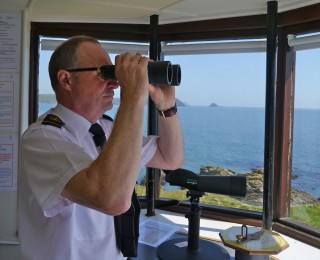 There is a constant need for new volunteers, particularly as we hope to increase the hours we cover during the summer months. 9.30am to 5.30pm, with 9.30am to 6.30pm in school holidays, is fine but I sometimes feel guilty as I shut up shop at 6.30pm on a fine summer’s evening and see children still in the water. Tragedy is not time limited.
There is a constant need for new volunteers, particularly as we hope to increase the hours we cover during the summer months. 9.30am to 5.30pm, with 9.30am to 6.30pm in school holidays, is fine but I sometimes feel guilty as I shut up shop at 6.30pm on a fine summer’s evening and see children still in the water. Tragedy is not time limited.
We need more men and women who can give us a few hours each month. It’s not difficult, good training is given, and most people can handle a Watch on their own after a few months. No one is going to throw you in at the deep end until we are sure you can cope. At the same time we want to be sure you know what is required of you so that everyone is clear about their commitment. That is why we say give us a ring first and talk about it. Try Sue on 01872-530500 or Chris on 01326-270681.
